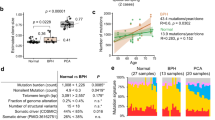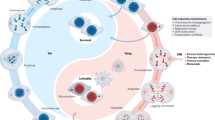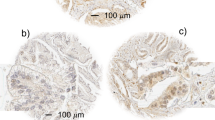Abstract
Molecular mechanisms of prostate cancer progression are poorly understood. Here, we studied gene amplification of the large conductance calcium-activated potassium channel alpha subunit (KCNMA1), which is located at the chromosomal region 10q22. Fluorescence in situ hybridization (FISH) revealed KCNMA1 amplification in 16% of 119 late-stage human prostate cancers and in the hormone-insensitive prostate cancer cell line PC-3. In contrast, KCNMA1 amplification was absent in 33 benign controls, 32 precursor lesions and in 105 clinically organ-confined prostate cancers. Amplification was associated with mRNA and protein overexpression as well as increased density of BK channel protein and β-estradiol-insensitive BK currents in PC-3 cells as compared to non-amplified control cell lines. Specific blockade of BK channels by iberiotoxin or RNAi significantly inhibited K+ currents and growth of PC-3 cells. The data demonstrate that 10q22 amplification drives KCNMA1 expression and cell proliferation. Thus, KCNMA1 qualifies as a promising diagnostic and therapeutic target in patients with prostate cancer.
This is a preview of subscription content, access via your institution
Access options
Subscribe to this journal
Receive 50 print issues and online access
$259.00 per year
only $5.18 per issue
Buy this article
- Purchase on Springer Link
- Instant access to full article PDF
Prices may be subject to local taxes which are calculated during checkout







Similar content being viewed by others
References
Albertson DG, Collins C, McCormick F, Gray JW . (2003). Chromosome aberrations in solid tumors. Nat Genet 34: 369–376.
Amberg GC, Bonev AD, Rossow CF, Nelson MT, Santana LF . (2003). Modulation of the molecular composition of large conductance, Ca(2+) activated K(+) channels in vascular smooth muscle during hypertension. J Clin Invest 112: 717–724.
Amberg GC, Santana LF . (2003). Downregulation of the BK channel beta1 subunit in genetic hypertension. Circ Res 93: 965–971.
Basrai D, Kraft R, Bollensdorff C, Liebmann L, Benndorf K, Patt S . (2002). BK channel blockers inhibit potassium-induced proliferation of human astrocytoma cells. Neuroreport 13: 403–407.
Bernardino J, Bourgeois CA, Muleris M, Dutrillaux AM, Malfoy B, Dutrillaux B . (1997). Characterization of chromosome changes in two human prostatic carcinoma cell lines (PC-3 and DU145) using chromosome painting and comparative genomic hybridization. Cancer Genet Cytogenet 96: 123–128.
Calderone V . (2002). Large-conductance, Ca(2+)-activated K(+) channels: function, pharmacology and drugs. Curr Med Chem 9: 1385–1395.
Christow SP, Bychkov R, Schroeder C, Dietz R, Haller H, Dumler I et al. (1999). Urokinase activates calcium-dependent potassium channels in U937 cells via calcium release from intracellular stores. Eur J Biochem 265: 264–272.
Coiret G, Matifat F, Hague F, Ouadid-Ahidouch H . (2005). 17-Beta-estradiol activates maxi-K channels through a non-genomic pathway in human breast cancer cells. FEBS Lett 579: 2995–3000.
Conti M . (2004). Targeting K+ channels for cancer therapy. J Exp Ther Oncol 4: 161–166.
Davies AG, Pierce-Shimomura JT, Kim H, VanHoven MK, Thiele TR, Bonci A et al. (2003). A central role of the BK potassium channel in behavioral responses to ethanol in C. elegans. Cell 115: 655–666.
El Gedaily A, Bubendorf L, Willi N, Fu W, Richter J, Moch H et al. (2001). Discovery of new amplification loci in prostate cancer by comparative genomic hybridization. Prostate 46: 184–190.
Galvez A, Gimenez-Gallego G, Reuben JP, Roy-Contancin L, Feigenbaum P, Kaczorowski GJ et al. (1990). Purification and characterization of a unique, potent, peptidyl probe for the high conductance calcium-activated potassium channel from venom of the scorpion Buthus tamulus. J Biol Chem 265: 11083–11090.
Hayward SW, Dahiya R, Cunha GR, Bartek J, Deshpande N, Narayan P . (1995). Establishment and characterization of an immortalized but non-transformed human prostate epithelial cell line: BPH-1. In vitro Cell Dev Biol Anim 31: 14–24.
Helenius MA, Saramaki OR, Linja MJ, Tammela TL, Visakorpi T . (2001). Amplification of urokinase gene in prostate cancer. Cancer Res 61: 5340–5344.
Helenius MA, Savinainen KJ, Bova GS, Visakorpi T . (2006). Amplification of the urokinase gene and the sensitivity of prostate cancer cells to urokinase inhibitors. BJU Int 97: 404–409.
Henke G, Maier G, Wallisch S, Boehmer C, Lang F . (2004). Regulation of the voltage gated K+ channel Kv1.3 by the ubiquitin ligase Nedd4-2 and the serum and glucocorticoid inducible kinase SGK1. J Cell Physiol 199: 194–199.
Ho SM . (2004). Estrogens and anti-estrogens: key mediators of prostate carcinogenesis and new therapeutic candidates. J Cell Biochem 91: 491–503.
Horoszewicz JS, Leong SS, Chu TM, Wajsman ZL, Friedman M, Papsidero L et al. (1980). The LNCaP cell line – a new model for studies on human prostatic carcinoma. Prog Clin Biol Res 37: 115–132.
Hsing AW, Tsao L, Devesa SS . (2000). International trends and patterns of prostate cancer incidence and mortality. Int J Cancer 85: 60–67.
Kaighn ME, Narayan KS, Ohnuki Y, Lechner JF, Jones LW . (1979). Establishment and characterization of a human prostatic carcinoma cell line (PC-3). Invest Urol 17: 16–23.
Kauraniemi P, Barlund M, Monni O, Kallioniemi A . (2001). New amplified and highly expressed genes discovered in the ERBB2 amplicon in breast cancer by cDNA microarrays. Cancer Res 61: 8235–8240.
Knuutila S, Autio K, Aalto Y . (2000). Online access to CGH data of DNA sequence copy number changes. Am J Pathol 157: 689.
Kononen J, Bubendorf L, Kallioniemi A, Barlund M, Schraml P, Leighton S et al. (1998). Tissue microarrays for high-throughput molecular profiling of tumor specimens. Nat Med 4: 844–847.
Koochekpour S, Zhuang YJ, Beroukhim R, Hsieh CL, Hofer MD, Zhau HE et al. (2005). Amplification and overexpression of prosaposin in prostate cancer. Genes Chromosomes Cancer 44: 351–364.
Kunzelmann K, Mall M . (2002). Electrolyte transport in the mammalian colon: mechanisms and implications for disease. Physiol Rev 82: 245–289.
Lau KM, LaSpina M, Long J, Ho SM . (2000). Expression of estrogen receptor (ER)-alpha and ER-beta in normal and malignant prostatic epithelial cells: regulation by methylation and involvement in growth regulation. Cancer Res 60: 3175–3182.
McCobb DP, Fowler NL, Featherstone T, Lingle CJ, Saito M, Krause JE et al. (1995). A human calcium-activated potassium channel gene expressed in vascular smooth muscle. Am J Physiol 269: H767–H777.
O’Grady SM, Lee SY . (2005). Molecular diversity and function of voltage-gated (Kv) potassium channels in epithelial cells. Int J Biochem Cell Biol 37: 1578–1594.
Olsen ML, Weaver AK, Ritch PS, Sontheimer H . (2005). Modulation of glioma BK channels via erbB2. J Neurosci Res 81: 179–189.
O’Malley D, Harvey J . (2004). Insulin activates native and recombinant large conductance Ca(2+)-activated potassium channels via a mitogen-activated protein kinase-dependent process. Mol Pharmacol 65: 1352–1363.
Orio P, Rojas P, Ferreira G, Latorre R . (2002). New disguises for an old channel: MaxiK channel beta-subunits. News Physiol Sci 17: 156–161.
Pardo LA . (2004). Voltage-gated potassium channels in cell proliferation. Physiology (Bethesda) 19: 285–292.
Pardo LA, del Camino D, Sanchez A, Alves F, Bruggemann A, Beckh S et al. (1999). Oncogenic potential of EAG K(+) channels. EMBOJ 18: 5540–5547.
Parihar AS, Coghlan MJ, Gopalakrishnan M, Shieh CC . (2003). Effects of intermediate-conductance Ca2+-activated K+ channel modulators on human prostate cancer cell proliferation. Eur J Pharmacol 471: 157–164.
Pei L, Wiser O, Slavin A, Mu D, Powers S, Jan LY et al. (2003). Oncogenic potential of TASK3 (Kcnk9) depends on K+ channel function. Proc Natl Acad Sci USA 100: 7803–7807.
Petrylak DP, Tangen CM, Hussain MH, Lara Jr PN, Jones JA, Taplin ME et al. (2004). Docetaxel and estramustine compared with mitoxantrone and prednisone for advanced refractory prostate cancer. N Engl J Med 351: 1513–1520.
Quirk JC, Reinhart PH . (2001). Identification of a novel tetramerization domain in large conductance K(ca) channels. Neuron 32: 13–23.
Rebhan M, Chalifa-Caspi V, Prilusky J, Lancet D . (1997). GeneCards: integrating information about genes, proteins and diseases. Trends Genet 13: 163.
Reiter RE, Sato I, Thomas G, Qian J, Gu Z, Watabe T et al. (2000). Coamplification of prostate stem cell antigen (PSCA) and MYC in locally advanced prostate cancer. Genes Chromosomes Cancer 27: 95–103.
Robitaille R, Charlton MP . (1992). Presynaptic calcium signals and transmitter release are modulated by calcium-activated potassium channels. J Neurosci 12: 297–305.
Sausbier M, Matos JE, Sausbier U, Beranek G, Arntz C, Neuhuber W et al. (2006). Distal colonic K(+) secretion occurs via BK channels. J Am Soc Nephrol 17: 1275–1282.
Tseng-Crank J, Foster CD, Krause JD, Mertz R, Godinot N, DiChiara TJ et al. (1994). Cloning, expression, and distribution of functionally distinct Ca(2+)-activated K+ channel isoforms from human brain. Neuron 13: 1315–1330.
Valverde MA, Rojas P, Amigo J, Cosmelli D, Orio P, Bahamonde MI et al. (1999). Acute activation of Maxi-K channels (hSlo) by estradiol binding to the beta subunit. Science 285: 1929–1931.
Van Coppenolle F, Skryma R, Ouadid-Ahidouch H, Slomianny C, Roudbaraki M, Delcourt P et al. (2004). Prolactin stimulates cell proliferation through a long form of prolactin receptor and K+ channel activation. Biochem J 377: 569–578.
Veldscholte J, Berrevoets CA, Ris-Stalpers C, Kuiper GG, Jenster G, Trapman J et al. (1992). The androgen receptor in LNCaP cells contains a mutation in the ligand binding domain which affects steroid binding characteristics and response to antiandrogens. J Steroid Biochem Mol Biol 41: 665–669.
Wang Z . (2004). Roles of K+ channels in regulating tumour cell proliferation and apoptosis. Pflugers Arch 448: 274–286.
Weaver AK, Liu X, Sontheimer H . (2004). Role for calcium-activated potassium channels (BK) in growth control of human malignant glioma cells. J Neurosci Res 78: 224–234.
Zhou XB, Wang GX, Ruth P, Huneke B, Korth M . (2000). BK(Ca) channel activation by membrane-associated cGMP kinase may contribute to uterine quiescence in pregnancy. Am J Physiol Cell Physiol 279: C1751–C1759.
Acknowledgements
We are grateful to Martina Mirlacher, Alex Rufle Hedvika Novotny, Ursula Dürrmüller and Dr Heide Tullberg from the Institute for Pathology, University Hospital Basel, and Dr Rainer Schreiber, Professor Dr Richard Warth and Melanie Spitzner at the University of Regensburg for their expert technical advice. We also thank Professor Dr Peter Ruth, Dr Matthias Sausbier and Ulrike Sausbier from the Institute of Pharmacy, University of Tübingen, Germany for generously providing the BK channel antibody.
The PC-3 cell line was kindly provided by Spyro Mousses, PhD (Translational Genomics Research Institute, Gaithersburg, MD, USA), LNCaP was from Meera Srivastava, PhD (Uniformed Services University of the Health Sciences, Bethesda, MD, USA) and BPH-1 was from Holger Rumpold, MD (Institute for Biomedical Ageing, Innsbruck, Austria).
This study was supported by the Stammbach Foundation/SWISS BRIDGE (KLS 01114-02-2001), by the Swiss National Science Foundation (Grant No. 3100A0-105413) and by the Deutsche Forschungsgemeinschaft DFG SCHR 752/2-1.
Author information
Authors and Affiliations
Corresponding author
Rights and permissions
About this article
Cite this article
Bloch, M., Ousingsawat, J., Simon, R. et al. KCNMA1 gene amplification promotes tumor cell proliferation in human prostate cancer. Oncogene 26, 2525–2534 (2007). https://doi.org/10.1038/sj.onc.1210036
Received:
Revised:
Accepted:
Published:
Issue Date:
DOI: https://doi.org/10.1038/sj.onc.1210036
Keywords
This article is cited by
-
Calcium-Activated Potassium Channel (KCNMA1) as Biomarker of Pre-Invasive and Invasive Cervical Cancer
Indian Journal of Gynecologic Oncology (2024)
-
The Role οf Ion Channels in the Development and Progression of Prostate Cancer
Molecular Diagnosis & Therapy (2023)
-
Genome-wide evaluation of copy gain and loss variations in three Afghan sheep breeds
Scientific Reports (2022)
-
Cancer stem cell transcriptome landscape reveals biomarkers driving breast carcinoma heterogeneity
Breast Cancer Research and Treatment (2021)
-
Novel DNA methylation signatures of tobacco smoking with trans-ethnic effects
Clinical Epigenetics (2021)



